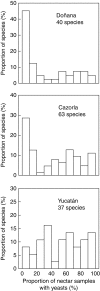Yeasts in floral nectar: a quantitative survey
- PMID: 19208669
- PMCID: PMC2701759
- DOI: 10.1093/aob/mcp026
Yeasts in floral nectar: a quantitative survey
Abstract
Background and aims: One peculiarity of floral nectar that remains relatively unexplored from an ecological perspective is its role as a natural habitat for micro-organisms. This study assesses the frequency of occurrence and abundance of yeast cells in floral nectar of insect-pollinated plants from three contrasting plant communities on two continents. Possible correlations between interspecific differences in yeast incidence and pollinator composition are also explored.
Methods: The study was conducted at three widely separated areas, two in the Iberian Peninsula (Spain) and one in the Yucatán Peninsula (Mexico). Floral nectar samples from 130 species (37-63 species per region) in 44 families were examined microscopically for the presence of yeast cells. For one of the Spanish sites, the relationship across species between incidence of yeasts in nectar and the proportion of flowers visited by each of five major pollinator categories was also investigated.
Key results: Yeasts occurred regularly in the floral nectar of many species, where they sometimes reached extraordinary densities (up to 4 x 10(5) cells mm(-3)). Depending on the region, between 32 and 44 % of all nectar samples contained yeasts. Yeast cell densities in the order of 10(4) cells mm(-3) were commonplace, and densities >10(5) cells mm(-3) were not rare. About one-fifth of species at each site had mean yeast cell densities >10(4) cells mm(-3). Across species, yeast frequency and abundance were directly correlated with the proportion of floral visits by bumble-bees, and inversely with the proportion of visits by solitary bees.
Conclusions: Incorporating nectar yeasts into the scenario of plant-pollinator interactions opens up a number of intriguing avenues for research. In addition, with yeasts being as ubiquitous and abundant in floral nectars as revealed by this study, and given their astounding metabolic versatility, studies focusing on nectar chemical features should carefully control for the presence of yeasts in nectar samples.
Figures


Similar articles
-
Micro-organisms behind the pollination scenes: microbial imprint on floral nectar sugar variation in a tropical plant community.Ann Bot. 2012 Nov;110(6):1173-83. doi: 10.1093/aob/mcs183. Epub 2012 Aug 22. Ann Bot. 2012. PMID: 22915578 Free PMC article.
-
Presence of yeasts in floral nectar is consistent with the hypothesis of microbial-mediated signaling in plant-pollinator interactions.Plant Signal Behav. 2009 Nov;4(11):1102-4. doi: 10.4161/psb.4.11.9874. Epub 2009 Nov 19. Plant Signal Behav. 2009. PMID: 20009562 Free PMC article.
-
Yeasts in nectar of an early-blooming herb: sought by bumble bees, detrimental to plant fecundity.Ecology. 2013 Feb;94(2):273-9. doi: 10.1890/12-0595.1. Ecology. 2013. PMID: 23691645
-
Yeast-nectar interactions: metacommunities and effects on pollinators.Curr Opin Insect Sci. 2021 Apr;44:35-40. doi: 10.1016/j.cois.2020.09.014. Epub 2020 Oct 14. Curr Opin Insect Sci. 2021. PMID: 33065340 Review.
-
Yeast-Bacterium Interactions: The Next Frontier in Nectar Research.Trends Plant Sci. 2019 May;24(5):393-401. doi: 10.1016/j.tplants.2019.01.012. Epub 2019 Feb 18. Trends Plant Sci. 2019. PMID: 30792076 Review.
Cited by
-
Identification of fungi isolated from commercial bumblebee colonies.PeerJ. 2024 Jan 30;12:e16713. doi: 10.7717/peerj.16713. eCollection 2024. PeerJ. 2024. PMID: 38313023 Free PMC article.
-
Physiological and behavioral pharmacology of ethanol in honey bees.J Comp Physiol A Neuroethol Sens Neural Behav Physiol. 2025 Jul;211(4):483-504. doi: 10.1007/s00359-025-01743-8. Epub 2025 May 21. J Comp Physiol A Neuroethol Sens Neural Behav Physiol. 2025. PMID: 40397064 Review.
-
Fungus-mediated plant-pollinator mutualism in Monoon laui (Annonaceae): functional differentiation of stigmatic exudate and petal nectar.BMC Biol. 2025 Jul 9;23(1):206. doi: 10.1186/s12915-025-02308-6. BMC Biol. 2025. PMID: 40629341 Free PMC article.
-
Honey as an Ecological Reservoir of Antibacterial Compounds Produced by Antagonistic Microbial Interactions in Plant Nectars, Honey and Honey Bee.Antibiotics (Basel). 2021 May 9;10(5):551. doi: 10.3390/antibiotics10050551. Antibiotics (Basel). 2021. PMID: 34065141 Free PMC article. Review.
-
Nectar-living yeasts of a tropical host plant community: diversity and effects on community-wide floral nectar traits.PeerJ. 2017 Jul 14;5:e3517. doi: 10.7717/peerj.3517. eCollection 2017. PeerJ. 2017. PMID: 28717591 Free PMC article.
References
-
- Adler LS. The ecological significance of toxic nectar. Oikos. 2000;91:409–420.
-
- APG (The Angiosperm Phylogeny Group). An update of the Angiosperm Phylogeny Group classification for the orders and families of flowering plants: APG II. Botanical Journal of the Linnean Society. 2003;141:399–436.
-
- Baker HG, Baker I. Studies of nectar-constitution and pollinator–plant coevolution. In: Gilbert LE, Raven PH, editors. Coevolution of animals and plants. Austin, TX: University of Texas Press; 1975. pp. 100–140.
-
- Baker HG, Baker I. Floral nectar sugar constituents in relation to pollinator type. In: Jones CE, Little RJ, editors. Handbook of experimental pollination biology. New York: Van Nostrand Reinhold; 1983. pp. 117–141.
-
- Baker HG, Baker I. The occurrence and significance of amino acids in floral nectar. Plant Systematics and Evolution. 1986;151:175–186.

